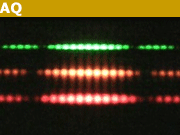Clarifying Common Issues with Indistinguishable Particles
Commonly there is a lot of imprecision in talking about ”indistinguishable” (or ”identical”) particles, even in serious work. This Insight article clarifies the issues involved in a conceptually precise way.
Classical mechanics. Historically, indistinguishable particles were introduced in order to explain the failure of the thermodynamics of a Newtonian ##N##-particle system to describe the absence of an entropy increase when mixing two volumes of the same substance. This assumption, which has no logical basis in classical mechanics but appears as an ad hoc device to save the theory, drastically changes the state space of the multiparticle system, the phase space of functions of positions and momenta, to a much smaller space of symmetric functions of positions and momenta.
Nonrelativistic quantum mechanics. The first quantum manifestation of indistinguishable particles was the Pauli exclusion principle, which states that wave functions of a nonrelativistic ##N##-electron system must be completely antisymmetrized. The same holds for other kinds of indistinguishable fermions, while for a system of indistinguishable bosons, the wave functions must be completely symmetrized.
As a result, in nonrelativistic quantum mechanics, the state space of indistinguishable particles is very different from that of distinguishable particles; nothing particle-like survives this change of basic setting.
The change completely destroys the very basis of a reasonable particle concept: the possibility to assign observables (self-adjoint operators) to the position of a particle inside a multiparticle system. There are no such observables. The reason is that observables must map correctly (anti)symmetrized multiparticle wave functions again to correctly (anti)symmetrized multiparticle wave functions.
For example, multiplication by ##x_k##, the standard position observable for particle ##k## in the distinguishable case, does not have this property. And if one correctly (anti)symmetrizes the result, the resulting operator only describes the center of mass of the system, not a property of individual particles. Similarly, one can consider multiplication by ##f(x_k)## for some arbitrary function ##f ##of a single position, and (anti)symmetrize the result. As result one gets the value of ##f(x)##, averaged over all positions ##x##. In other words, the observables that one still can form, correspond to integrals of the form
$$N(f)= \int dx f(x)\rho(x),$$
where ##\rho(x)## denotes the particle density at the position ##x##. The alleged particle theory has no particle-like observable properties at all – these dissolved under our analysis and lead instead to a particle density field. Thus we are forced to acknowledge that a quantum theory of indistinguishable ”particles” is in fact a quantum field theory and only a quantum field theory!
Indeed, this is made formally precise by the concept of ”second quantization”, usually introduced in statistical mechanics, where the field view is indispensable. In the nonrelativistic case of a field of structureless and spinless particles, it is easily checked that the particle density can be written as ##\rho(x)=a^*(x)a(x)##, where ##a(x)## is the annihilator operator (or rather operator-valued distribution) in the position representation.
On the other hand, if one starts with an annihilator field ##a(x)## satisfying canonical commutation rules, one gets indistinguishable particles for free. Thus indistinguishable particles are one of the most elementary consequences of the quantum field concept!
Relativistic quantum mechanics. Nothing essential changes in the above discussion when one considers relativistic quantum mechanics of massive particles in the (then existing) position representation.
Thus the concept of indistinguishable particles is completely superseded by the concept of a quantum field. The latter gives the right intuition about the meaning of the formalism, and the former (which is difficult to justify and even more difficult to interpret intuitively) is completely dispensable.
How then do the familiar ideas about particles reappear in the quantum field setting? This is succinctly answered by quoting Steven Weinberg: ”In its mature form, the idea of quantum field theory is that quantum fields are the basic ingredients of the universe, and particles are just bundles of energy and momentum of the fields.” (see p.2 of his essay, ”What is Quantum Field Theory, and What Did We Think It Is?” )
We see individual photons when they directly fall into our eyes. But these photons are not described by single-photon states of QED but effective photons (part of a very complex state of the electromagnetic field) distinguished by their position. Particles we can see through an electron microscope, say, appear there as lumps with slightly fuzzy boundaries, described by a field density. In the most precise experiments, we hear sounds, read pointers or digital numbers, or see ionization tracks that are only indirectly related to pointlike particles – whose existence we pretend to infer, but in fact simply (and falsely) assume.
Making particles distinguishable. In statistical mechanics one often studies effective theories where there are additional means of distinguishing particles. Two important examples:
- In modeling molecular fluids, two atoms on the same molecule are distinguishable if and only if there is no molecular symmetry interchanging the two atoms, and two atoms in different molecules are distinguishable if and only if there is no congruent matching of the two molecules such that the two atoms correspond to each other.
- In modeling the solid state, one typically assumes that the atoms are confined to lattice sites and that each site is occupied at most once. In this case, the position in the lattice is a distinguishable label, which makes all atoms distinguishable.
Indistinguishable particles and entanglement. Many people regard indistinguishable particles as being intrinsically entangled. However, to talk usefully about entanglement, the systems that are considered to be entangled must be distinguishable (usually, by their position or momentum).
Indeed, the common assumption in a formal definition of entangled systems, here quoted from Wikipedia, is: ”The Hilbert space of the composite system is the tensor product”.
This is violated for indistinguishable bosons or fermions, where the Hilbert space of the composite system is not the tensor product but the symmetrized and antisymmetrized tensor product, respectively.
The state-space of indistinguishable particles is very different from that of distinguishable particles. Almost nothing particle-like survives this change of basic setting. In particular, the prerequisites for Alice and Bob doing the usual kinds of experiments on entanglement cannot be performed in principle if the particles involved are indistinguishable.
For example, two electrons are on the fundamental level indistinguishable; their joint wave function is proportional to ##|12\rangle-|21\rangle##; no other form of superposition is allowed. Similarly, two photons are on the fundamental level indistinguishable; their joint wave function is proportional to ##|12\rangle+|21\rangle##; no other form of superposition is allowed. On the other hand, a photon and an electron are intrinsically distinguishable (e.g. by their spin), and arbitrary superposition is possible.
However, in practice one often knows already that (by preparation) there are two electrons or two photons, one moving to the left and one moving to the right, one can use this information to distinguish the electrons or photons: The particles are now described by independent, much smaller effective Hilbert spaces, which makes them distinguishable effective objects. Therefore, one can assign separate state information to each of them, and construct arbitrary superpositions of the resulting tensor product states. Therefore, these effective, distinguishable particles can be (and typically are) entangled.
Full Professor (Chair for Computational Mathematics) at the University of Vienna, Austria










Obviously I read a different paper…
This is essentially a 1D calculation since only the radial coordinate is used. It does not work for neutral hydrogen or any other composite molecule.
Hi Hendrik,
he doesn't start with a Slater determinant but with a function where ##r_1 \le r_2##. Symmetry or antisymmetry of the spatial part is explicitly guaranteed by boundary conditions at ##r_1 = r_2##.
I still don't understand what "shell wavefunctions" or "sector wave functions" are…
https://link.springer.com/article/10.1007/BF01375457
In this case I should have better spoken maybe of shell wavefunctions than of sector wave functions.
What I mean is that you consider the radial distance of electron 1 to be always lower than that of electron 2.
Well, as @A. Neumaier very convincingly argues in his very nice article, the most convenient way to deal with many-body systems of indistinguishable particles (in the relativistic case it's a necessity because of the possibility of particle creation and destruction already in two-body collisions) in terms of a quantum field theory.
The position operator can be defined for all massive particles in the relativistic case through the representation theory of the Poincare group. For massless particles it's only possible to define a position operator in the strict sense for spin ##\leq 1/2##. For details see @A. Neumaier 's theoretical-physics FAQ
https://www.mat.univie.ac.at/~neum/physfaq/topics/position.html
In the non-relativistic case it's simply the center of mass operator (here written in the Heiseberg picture
$$\hat{\vec{R}}=\int_{\mathbb{R}^3} \mathrm{d}^3 r \vec{r} \hat{\psi}^{\dagger}(t,\vec{r})
\hat{\psi}(t,\vec{r}).$$
Dimension 1 is special since particles can there be distinguished by their relative location, but only when coordinates are distinct. If two coordinates agree one cannot tell which particle moves left and whch moves right. Moreover, if you measure one particle position and don't know where the others are, you cannot tell which particle coordinate you measured. Thus the problem remains.
In 2D, there are no natural sectors, unless you fix a center. And even then there remains a rotational indistinguishability requirement. In 3D, sectors cannot even be naturally ordered.
In any case, for applications in chemistry there is no way to distinguish the hydrogen atoms in CH_4 or NH_3, say.
I am not sure, whether particle statistics really forbids to introduce position operators.
For me, the (anti-) symmetrization is somehow secondary.
E.g., in one dimension, indistinguishability means that it suffices to consider ordered coordinates x1<x2<x3 …<xn. In higher dimensions this generalizes to sectors. The (Fermi, Dirac or para-) statistics is hidden in the boundary conditions on the sector borders (for 2d, there exists also the possibility of anyons).
A position operator for particle i can then be formulated as ##\int dx x\delta(x_i-x)##.
Working in a larger but redundant space with any order of the xi may offer other advantages, but it is not driven by mathematical necessity, at least not in non-relativistic QM.
There is a topological argument by Laidlaw and deWitt why in ##\geq 3## spatial dimensions one can have only boson or fermion statistics of indistinguishable particles, while in 2 spatial dimensions you can have "anyon" statistics. Indeed anyonic quasiparticles are observed in condensed-matter physics, e.g., related to the fractional quantum Hall effect.
M. G. G. Laidlaw, C. M. DeWitt, Feynman Functional
Integrals for Systems of Indistinguishable Particles, Phys.
Rev. D 3 (1970) 1375.
https://link.aps.org/abstract/PRD/v3/i6/p1375
The relativistic QFT description of anyons is developed in
Fröhlich, J., Marchetti, P. Quantum field theory of anyons. Lett Math Phys 16, 347–358 (1988).
https://doi.org/10.1007/BF00402043
I mean that the physical Hilbert space ##\cal H## is not a dense subspace of the tensor product, and the position operator of the first particle, as an operator on the tensor product, does not map a dense subspace of ##\cal H## into ##\cal H##. But the latter is required for operators with a physical meaning.
The notion of an elecron being in a particular energy level is already a notion of a particular approximation scheme that describes the multielectronic wave function in the full Hilbert space in terms of a reduced, simplified description based on a tensor product of Hilbert spaces for electrons with fixed energy levels – a degenerate extension of the Hartree-Fock approach.
In this reduced description, the two electrons in a particular degenerate energy level are indistinguishable, and the electron pairs in different energy level are distinguishable and entangled. However, it is not clear to me how useful the terminology is in this case.
Regarding the discussion of entanglement and when it makes sense to use that term: consider an atom with electrons in multiple energy levels in its ground state (for example, beryllium, with two 1s electrons and two 2s electrons). Would it make sense to say that the electrons in a particular energy level (e.g., 1s) are indistinguishable and therefore it's not useful to talk about them being entangled, whereas the electrons in different energy levels (e.g., 2s vs. 1s) are distinguishable and therefore it is useful to talk about them being entangled (so the overall ground state of the Be atom could be described as an entangled state of two 1s electrons and two 2s electrons)?